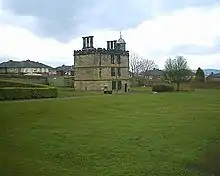Jean Champhuon, sieur du Ruisseau
Jean or Jehan Champhuon, sieur du Ruisseau was a French lawyer and an administrator and chamberlain of the estates of Mary, Queen of Scots. He served on her French council.[1][2]
Family connections
Increasingly over the years, the French lawyers and clerks serving Mary in England were drawn from closely related families. Du Ruisseau married Claire Nau in 1563, her younger brother Claude Nau became Mary's secretary for the French language during her years in England. Jérôme Pasquier, a household clerk for Mary in England was married to their daughter Madeleine Champhoun.[3]
Du Ruisseau was master of Mary's (French) accounts from 1575.[4] His brother, Pierre Champhuon, joined Mary's French council in 1584.[5]
In a letter to Claude Nau, Albert Fontenay, a diplomat and relation of Claude Nau, described M. du Ruisseau's affection to their cousin "de Beauvois" and their mutual blood relatives of the surname Nau. Du Ruisseau was going to help negotiate Fontenay's marriage to the daughter of Masuyer, another Parisian lawyer already within their family circle.[6]
Roles

Jean Champhuon served on Mary's council for her French estates. He was promoted to be Mary's chancellor and keeper of her seals for French administration on 2 May 1585.[8] He was frequently mentioned in her correspondence for money matters and as a conduit for the passage of her letters to her allies and the French court.[9]
The French ambassador in London, Michel de Castelnau, helped get a passport for Du Ruisseau so he could travel and help Mary in her affairs. He visited Mary at Sheffield Manor, and was thought to be involved in international intrigue to restore Mary to rule. He was detained by the Earl of Shrewsbury at Sheffield for a month.[10] Ruisseau was then allowed to take some of Mary's requests to Elizabeth, who responded point by point.[11] Letters from Mary in code, identified in the Bibliothèque nationale de France and newly deciphered in 2023 include her responses to these events.[12]
Du Ruisseau looked after the finances of members of Mary's household in England. On 20 March 1586, at Chartley, Jérôme Pasquier and Bastian Pagez witnessed a document in which Jacques Gervais, Mary's surgeon, placed his affairs in the hands of Jean Champhuon, sieur du Ruisseau.[13]
Invasion plans
In September 1583, Mary arranged for Du Ruisseau to have an audience with the Duke of Guise to discuss possible plans in response to the Raid of Ruthven in Scotland. The pro-English coup had upset her scheme for an "association" with her son James VI. Possibilities included taking James VI to France and invading Scotland with 600 musketeers, possibly with papal funding. Mary envisaged a landing at Dumbarton Castle and the capture of Blackness Castle and Stirling Castle.[14]
References
- Katy Gibbons, English Catholic Exiles in Late Sixteenth-century Paris (Boydell, 2011), p. 79: Fanny Cosandey, Dire et vivre l'ordre social en France sous l'Ancien Régime (Paris, 2005), p. 109.
- William Barclay Turnbull, Letters of Mary Stuart (London, 1845), p. 345.
- Bulletin de la Commission historique et archéologique de la Mayenne (1921), p. 170: Claire Regnault gives a house to her daughter Claire Nau, Archives nationales
- H. Omont, 'Nouvelles Acquisitions', Bibliothèque de l'École des chartes, 89 (Paris, 1928), p. 287
- Bulletin de la Commission historique et archéologique de la Mayenne, t. 4 (Laval, 1892), p. 252: Seymour de Ricci & William Jerome Wilson, Census of Medieval and Renaissance Manuscripts in the United States and Canada, vol. 2 (1935), p. 1164 no. 4
- Sheila R. Richards, Secret Writing in the Public Records (HMSO, 1974), pp. 30, 42.
- John Daniel Leader, Mary Queen of Scots in Captivity(Sheffield & London, 1880), p. 511.
- American Book Prices, 1979-1983 (Bankroft-Parkman, 1984), p. 274
- Alexandre Labanoff, Lettres de Marie Stuart, 5 (London, 1844), p. 339.
- John Daniel Leader, Mary Queen of Scots in Captivity(Sheffield & London, 1880), pp. 509–512: Agnes Strickland, Letters of Mary, Queen of Scots, 2, p. 36.
- William K. Boyd, Calendar State Papers Scotland, vol. 6 (Edinburgh, 1910), pp. 188 no. 192, 194 no. 199, 205 no. 204.
- George Lasry, Norbert Biermann, Satoshi Tomokiyo, 'Deciphering Mary Stuart’s lost letters from 1578-1584', Cryptologia, 47:2 (2023), pp. 101-202. doi:10.1080/01611194.2022.2160677
- J. Charavay, Catalogue d'une très belle collection de lettres autographes et manuscrits (Paris, 1855), p. 18 no. 202: H. Omont, 'Nouvelles acquisitions du département des manuscrits de la Bibliothèque nationale pendant les années 1924-1928', p. 287 no. 23166
- William Barclay Turnbull, Letters of Mary Stuart (London, 1845), pp. 307-311.